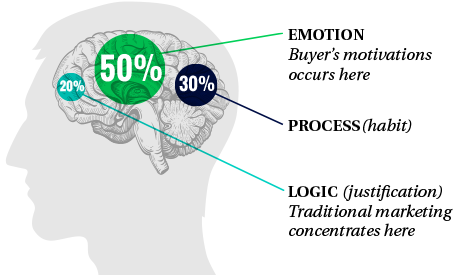
Marketing insiders have always known that there was an elusive element used by successful executives – it was not taught in business school but it was critical to marketing success. What’s the secret? Simply understanding that the logical, linear, mathematical ordered world of business may work for accounting, production, scheduling, or even business law, but it’s worthless for marketing because marketing deals with people and their emotions.
People are not logical. They change their minds. They are fickle. They act on impulse. However, despite what most would tell you, their responses are entirely predictable.
The method that makes sense of the quagmire of conflicting emotions, habits, and thoughts is known as Whole Brain Marketing because it creates appeals that work on all parts of the brain. Using scientific analysis of buying patterns and processes, the technique creates marketing programs that motivate changes in purchase behavior.
Most sales and marketing programs deal only with buyer’s thinking process and frequently produce no measurable revenue increases. False beliefs that people buy rationally inevitably result in “sound, logical” failed marketing programs. Many eventually resort to expensive discounting, costly retail promotions, celebrity endorsements, and hype. The result: astronomical marketing costs, customer complaints about high prices, dismal advertising response, and constantly reacting to the “market leader.”
astronomicalmarketing costs
complaintsabout high prices
dismaladvertising response
reactingto the market leader
Many marketing programs also attempt to appeal only to the thinking part of the brain, the cerebral cortex. While this portion of the brain is used for evaluating decisions, it is irrelevant in creating motivation. These misguided marketing plans are often based solely on marketing research data, which almost always is from this rational part of the brain and nearly useless in predicting buyer behavior. This research offers even less value in guiding advertising or promotion efforts: rational thinking doesn’t matter until buyers begin to justify a purchase or weigh alternatives. Logical appeals will not motivate new sales.
Consider that emotions begin in an unconscious part of the brain called the limbic system. Access to the limbic system requires skill in indirectly eliciting and observing mental processes that are mostly unconscious. The great majority of market research does not consider or measure the limbic system or emotions, and is, therefore, virtually worthless in understanding motivation. The resulting marketing strategy and advertising will by definition also be of no use in motivating purchases and will inevitably lead to failed marketing programs as well.
In contrast, effective marketing strategy begins with understanding customers’ emotional responses. It asks what customers’ underlying desires might be related to the product or service and understands problems customers want to solve. Only after a prospect becomes excited about experiencing the positive emotion or avoiding negative ones do they then turn to the logical parts of the brain to evaluate a purchase. Since most marketing presentations, advertisements, and promotions never produce desire or motivation, the more logical points of marketing appeals are never even seen because they are irrelevant or ignored.

Uncovercustomers’ underlying desires and the problem(s) they want to solve.
Targetthese desires and problem(s) in marketing messages.
Suggesta buying process that aligns with customers’ normal purchasing patterns.
The final critical part of a successful marketing campaign is matching prospective customers’ buying processes or habits. Habits are processed in the reptilian brain and, like the emotions, are mostly unconscious and often ignored by marketers. Prospects have specific habits or patterns that they follow in evaluating a particular type of purchase. If advertising suggests the process they would naturally follow, they’ll usually being to execute their buying process. If not, they may or may not create it for themselves. By understanding the three parts of the brain’s role in behavior, we can create marketing strategy that will be consistently effective.
If these three parts of motivation are incorporated into marketing messages, customers will desire to buy comfortably and naturally, assuming that your product and service is at least viable and somewhat competitive with competitors’. An added benefit of a motivated customer is that they will recognize the value of your product or service and will not require the aforementioned failed marketing gimmicks.
The Whole Brain Marketing process utilizes interviews derived from modern brain theory, psychology, and computer modeling to identify unconscious buying appeals to logic, emotions, and habits simultaneously to produce motivation and create action. Advertising, sales promotion, web designs, and strategy based on Whole Brain Marketing create the sort of marketing breakthroughs most think to be impossible.